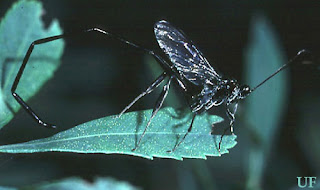Ø Grubs belong to family Scarabaeidae.
Ø Grubs are larvae of May beetle also called June beetle
or Japanese beetle
Ø 200 species exists.
Ø Larvae live underground attack mostly on roots of corn,
potato, tomato, wheat ,beans and turnip
Life Cycle :
The Phyllophaga life
cycles vary somewhat because some species complete their growth in one year,
some require as much as four years.
The adults mate in the evening and, at
dawn, females return to the ground to deposit 15 to 20 eggs, 1 to 8 inches deep
in the soil.
hatch about three weeks later into young
larvae that feed upon roots and decaying vegetation throughout the summer and,
in autumn, migrate downward (to a depth of up to 1.5 meters) and remain
inactive until the following spring. for more click here
The greatest amount of damage
occurs as the larvae move near the soil surface to feed on the roots of the
plants. The next autumn the larvae again migrate deep into the soil to
overwinter, returning near the soil surface the following spring to feed on
plant roots until they are fully grown in late spring
These grubs then form oval earthen cells
and pupate. The adult beetles emerge from the pupal stage a few weeks
later, The beetles overwinter in the soil, emerging the following year in May
or June when feeding, mating, and egg-laying take place.
CONTROL MANAGEMENT:
Cultural Control
·
The greatest damage to crops occurs the year after the appearance of the
adults.
·
The year following heavy flights of May beetles, planting corn or
potatoes should be avoided in fields that were previously under sod
or grass.
·
During the years of heavy May beetle infestation, deep-rooted legumes,
such as alfalfa or clovers, should be planted.
·
Farmers should apply only well decomposed farmyard manure in fields.
Biological control:
A pelecinid wasp,
a natural enemy of white grubs.
·
A pyrgotid fly,
a natural enemy of white grubs,
Mechanical Control:
Use of different traps like Light
traps are most effective for control of adult in the May-July is helpful in
reducing the population of grubs for the next season.
Chemical Control
Ø Maize crop can be
protected through pre-sowing soil application of Agrotox/Phorate 10G
@1.5Kg/Kanal.
Ø In standing
crops Biomax / Chloropyriphos 20ec may be applied with
irrigation
for more Click here







.jpg)

.jpg)

"This is such a timely and practical guide! White grubs have been a nightmare in my lawn, and I’ve been searching for eco-friendly solutions. Your tips on using neem oil and introducing beneficial nematodes are especially helpful. Have you found any particular nematode species (Steinernema or Heterorhabditis) to be most effective against grubs? Also, would you recommend applying milky spore powder as a long-term preventive measure? Thanks for sharing these sustainable strategies—I’m excited to try them out and save my garden.
ReplyDelete